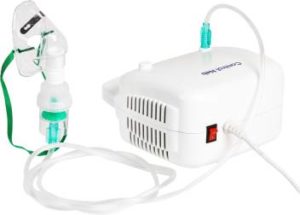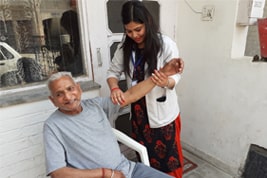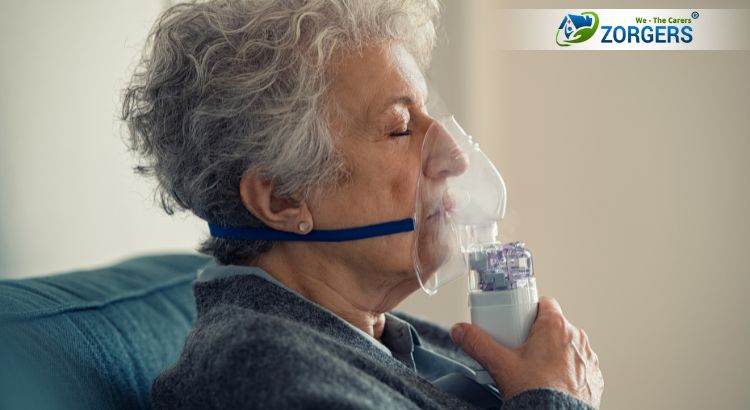Nebulization is the process of drug delivery for which a machine is used. A nebulizer is a drug delivery machine that helps by directly sending the medicine into the lungs in the form of mist. This process is mainly used in cases of severe respiratory infection and problems. And, in some cases of extreme congestion of chest and nose too, nebulization is recommended many times by the doctor, since it provides instant relief by opening the airways.

In the process of nebulization, a solution of the drug is transformed into a fine spray or a mist. It is delivered in the entire respiratory tract during breathing. A breathing mask covering the nose and mouth is fixed and during breathing, medication reaches the lungs via the respiratory tract. The main principle involved in the nebulization process consists of the usage of oxygen, and ultrasonic power or compressed air to break up the drug solution inside the machine and deliver it as per the dose to the patient.
Several types of nebulizers are available in the market like- Jet Nebulizers and Ultrasonic Nebulizers. Among these Ultrasonic Nebulizers are expensive ones and re preferred within the hospital setups whereas Jet Nebulizers are preferred during at-home nursing care of the patient. According to the severity of the patient’s breathing condition medication for nebulization can be prescribed by the doctor. In some cases, a doctor can also recommend a non-medicated saline solution for the purpose of moistening the nasal pathway. The recommended procedure steps, drug, and dose must always be strictly adhered to nebulization to reap effective results.
Availing home nursing visits for the nebulization
At home respiratory care can be managed with the help of a well-trained nurse for nebulization at home. Professional home nursing care companies like Zorgers can help in therapeutic respiratory procedures in-home which are prescribed by the physician for the treatment. There are some very clear benefits of availing at home visits:
– It is easy to get hold of pediatric and adult nebulization expert/nurse for this process in the comfort of their home.
– Proper care of a kid or elderly during nebulization relieves a person from worries even in the absence.
Although the nebulizer device is simple to operate it becomes mandatory to clean and maintain it as per the manual or instructions. So, the primary healthcare provider like a nurse can efficiently help in doing that.
For several acute exacerbation airways diseases educating and providing correct nebulization therapy make nurses a trusted hand of the doctors. A nurse is well trained to handle nebulization with precautions and providing an appropriate recommended dose of the medicine. A nurse can also train the patient with the correct breathing procedure during the process of nebulization to reap maximum benefits from it in a short span. A nurse even monitors carefully during the process to ensure proper oxygen amount is being received by the patient to prevent any risks during at-home care.
So, opting for a trained and caring nurse from the home care service provider makes optimum respiratory care easier to manage at home. A nurse can further teach the right way of handling and using a nebulizer for the best positive, and effective results by avoiding any complications. No matter if the patient is a kid, adult, or elderly the at-home care provider nurse can handle all with utmost care keeping them safe.
Why is nebulization done?
The main purpose of nebulization is to make the medications reach out in the airways. It is mainly done in cases of severe lung conditions where medication is required in the airways via aerosol drug delivery systems. Inhaled medications relieve symptoms like wheezing, chest tightness, breathlessness and even controls phlegm and mucus buildup. It also prevents future flare-ups.
Some facts about nebulization:
– It is used in cases of severe lung conditions only after prescription and not for self-medication purposes.
– Handheld inhalers are not as effective as nebulized medicine, so it is preferred.
– A nebulizer is beneficial in cases of children and elderly with severe health conditions who cannot rely on other inhalers for drug delivery in the body.
When or in which diseases or conditions nebulization is required?
Nebulization is mainly prescribed to those who suffer from some significant lung disorders or respiratory disorders. Some of them include:
– Cystic fibrosis
– Asthma
– Chronic Obstructive Pulmonary Disease or COPD
– Bronchiectasis
– At times, a child with a respiratory infection like bronchiolitis is also prescribed with the nebulizer
What is the recommended best position during nebulization?
During the process of nebulization, the drug is delivered via nebulizer which consists of a small plastic bowl-shaped covering for the face with a screw-top lid. It must be correctly positioned in front of the nose and mouth.
The airflow in the nebulizer transforms the medication solution into a mist. If inhaled properly while sitting on a chair or else even on a bed the medication has a better chance to reach out to the smaller sections of the airways. It further enhances the effectiveness of the medication.
Following are a few steps for proper nebulization:
1. Help the patient sit straight and explain the process to the patient.
2. Attach the breathing mark properly.
3. Hold the nebulizer in an upright position to prevent any spilling.
4. Fill the medicine cup with the medication along with an appropriate saline solution as prescribed by a doctor.
5. Continue deep breathing throughout the nebulization process. It allows the medication to penetrate the entire airway.
6. Continue until inconsistent nebulization or sputtering appears.
Although nebulizer positioning has a very little clinically significant effect over the ventilator performance. However, it has been studied that keeping nebulizer closer to ventilator or evaluation valves lowers the drug delivery efficiency.
Which medications are used during the nebulization process and which precautions need to be taken?
Following are the medications used in the nebulization process:
1. Short-acting Beta-2 agonists:
– Albuterol
– Levalbuterol
2. Long-acting Beta-2 agonists:
– Formoterol
– Arformoterol
3. Sort-acting drug in combination:
– Ipratropium
– Albuterol
4. Corticosteroid:
– Budesonide
These medications are available under different brand names and dosages. The recommended dosage of the drug is prescribed by the doctor after a complete evaluation of the disease condition and its severity. Below are some of the precautions for the nebulization process:
– A nebulizer must only be used if prescribed and not against anyone’s advice except the doctor.
– Always wash your hands before using a nebulizer to avoid any chances of germs and related infections.
– The expiration date and discoloration of the medication must be checked before use.
– A medication that appears damaged or is not intact in its original form must not be used.
– Medications and nebulizer must always be kept away from the children.
– Medications must be stored in a cool dry place away from extremes of hot and cold under the recommended conditions.
– Maintaining the nebulizer is also important hence, wash, dry, and store it as per the manual instructions.
– Keeping a weekly check on the filter of the nebulizer. It must be once in a month or as per the requirement depending upon the frequency of usage.
Appropriate care and usage of the nebulizer is a must for maintaining the good health of the patient.






After reading this blog I understood the importance of patient care services. Thanks for sharing such useful posts with us.
Hello, Such a great post. All the information on this blog is best for us. Thanks a lot for publishing this unique and informative blog.
Thank you for sharing the benefits of Home Nursing Visits for Nebulization
Works exactly as described and is extremely easy to use. Small & portable making it easy to take around if needed.
Thanking you for sharing the great information’s. This was an useful blog for Care Coimbatore is one of the leading primary health care service center providers in and around Coimbatore, based on measures of patient safety, quality, cost, patient satisfaction and staff engagement
Home nursing visits for nebulization have been life-changing! The personalized care and convenience make treatment much more comfortable and effective. Highly recommend for anyone needing consistent, compassionate care at home.